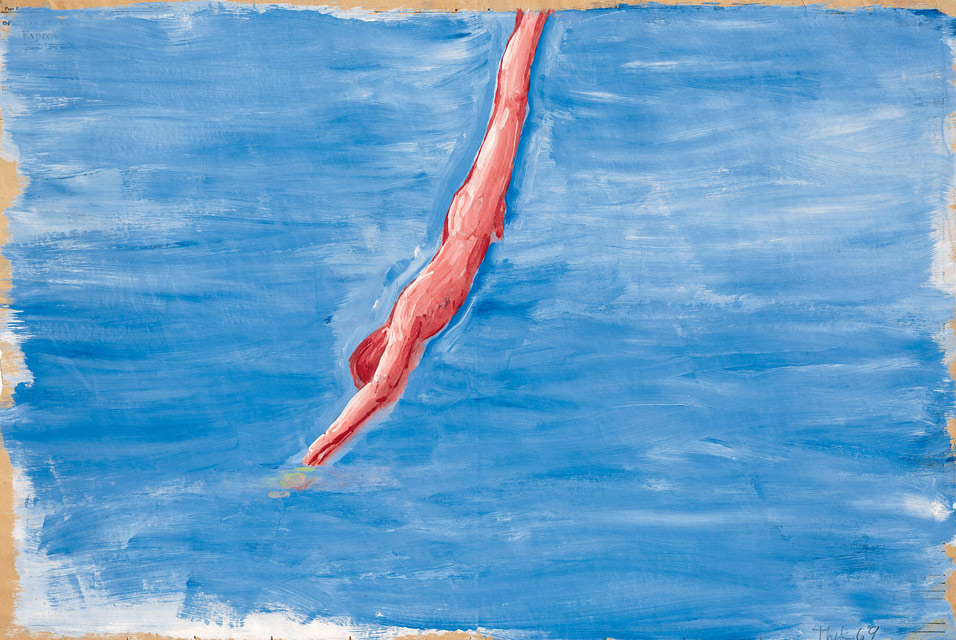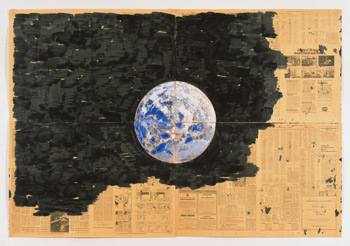Diver, 1969–1970
Paul Thek (November 2, 1933 - August 10, 1988) was an American painter and, later, sculptor and installation artist. Born in Brooklyn, he studied locally, at the Art Students League and the Pratt Institute. In 1951 he entered the Cooper Union.
Although Thek began as a painter, he became known later in life for his sculptures and installations. Notable works include Technological Reliquaries (1964–67), a series of wax sculptures of human body parts, and The Tomb, a bright pink pyramid installation or "environment", which was badly damaged in 1981 but is documented in Edwin Klein's black and white photographs. Today his work may be seen in numerous collections, including that of the Hirshhorn Museum and Sculpture Garden in Washington, D.C. and the Whitney Museum of American Art in New York.
Thek, who was bisexual, died of AIDS related illness in New York City in 1988, aged 54.
http://en.wikipedia.org/wiki/Paul_Thek
Untitled (Earth Drawing I), c. 1974
Thek’s use of newspaper in his installations and as a drawing support
began in 1969 and was a recurring element of his work until his
death in 1988. The dates and types of newspaper reflect where
he was living. During the mid-1970s Thek typically isolated a
single image (i.e. dinosaur, ‘hot’ potato or dish of prunes)
against an opaque ground of color painted on pages of the International Herald Tribune.
The newspaper works of the early 1980s are more abstract,
allover in their composition, and diverse in color. In these
works, painted on pages of The New York Times, Thek increasingly allowed transparency to reveal articles of interest.
Ariel Phillips
http://newspaperpaintings.wordpress.com/2011/02/11/paul-thek-newspaper-paintings-1981-1983/
Red Turtle, c. 1974
Thek was throughout his career a prolific and occasionally brilliant painter
and draftsman. When he returned to New York in 1979 after his
peripatetic years in Europe, he focused on small painted works,
primarily on his preferred support of newspaper, often installing them
low on the wall in dime-store frames with elementary-school desk chairs
in front of them, as if to suggest the ideal viewer for these
exuberantly colored and deeply sentimental works. (Thek, one might
argue, was always creating for a future audience rather than the one at
hand.) If his loose and mannered amateurism resonated with the
expressionist revival of painting in the 1980s, the overall modesty of
scale and subject matter in his works provides a welcome riposte to the
more grandiose aspects of that moment of postmodern painting. In his
contribution to Artist’s Artist, Kenny Schachter perceptively identifies
how Thek’s newspaper paintings partake in the underlying motif of decay
within the artist’s oeuvre, aligning them with the meat pieces (a
relationship further emphasized by Thek’s penchant for framing many
newspaper paintings in Plexiglas). The exhibition makes a surprisingly
strong claim for Thek as a painter, and perhaps it is in these
works—which seem in many ways the least influential and celebrated of
his oeuvre, but demonstrate most clearly such central themes as
imagination, ephemerality, and marginality—that the essence of Thek’s
artistic achievement can be best recognized.
Robert Slifkin
http://artjournal.collegeart.org/?p=2336
Grapes, 1974-5
The newspaper works of Paul Thek, which began in earnest in late 1960's
and continued unabated until his death in 1988, had a narrative arc
defined by an idiosyncratic expression of hope and beauty, and ended in a
more ambiguous state of disillusionment. They are narrative parables
sharing as much with literature, history and religion as with the
history of art. The early newspaper works at times resemble visceral
children's illustrations depicting Thek's inimitable ideals of happiness
and love with an eternal quality above and apart from the material
world. Though he exhorted to "Fall in love with your life" in note pad
musings, within the same page of unbridled optimism were signs of
tragedy and torment, "We're all crying children together".
Though the newspaper works appeared random and at times resembled
writing more than drawing, as a whole they constituted a visual diary
and travelogue. There was an ascetic quality to the systematic way in
which Thek recorded his life continually over the entire course of his
career. You can practically hear the silence, the meditative nature of
the process of the making of the newspaper works but they are also
imbued with the quality of sheet music that reverberates off the page.
In Thek's work no subject evaded his mockery, mirth and empathy, a touch
that managed to be both cynical and idealistic. Like fully formed pages
from an oversized sketchbook, the newspaper works could appear
classical, cartoonish, or like thought-bubbles, there was no telling.
There were grapes on vines, potatoes, seascapes, landscapes, garden
dwarfs, snakes, dinosaurs, hammers and sickles, and the Statute of
Liberty—the whimsical and the lighthearted, but there was always more to
be read. They offered an uncensored snapshot of Thek's mind's eye.
These works were possessed of a many layered, philosophical, and ageless
conceptual delicacy—a traditional conception of beauty in the hopeful,
transcendent sense of the word. Not indulgent, self-congratulatory, or
clichéd but celebratory and all embracing. On-its-sleeve emotional, and
romantic nevertheless.
Near the end, Thek purposefully abandoned the refinement and
representational insight of his earlier works reflecting his physical
and emotional state, afflicted by an incurable, stigmatized disease and
career neglect in his homeland. In the last newspaper works, gone are
the childlike exuberance and celebration of nature, replaced by a duller
form of abstractionism, signifying loss of love, innocence, and life.
His version of Yankee enthusiasm, cheerfulness and energy, which
remained throughout his sojourn in Europe, were hardheartedly quelled.
After a shortened but fertile lifetime of unstoppable invention, Thek
became a curmudgeon scarred by disregard and inattention. Even though he
was cut down prematurely, Thek still managed to produce astounding,
prescient and unparalleled work in every conceivable medium. The breadth
of the newspaper works alone reflect a military discipline and
self-control hardly seen during the time, and rarely so today. Thek's
was a restless and relentless pursuit only now being taken seriously
into consideration in relation to art before and after. Like Tonio
Kroger, Thek resembled the character in the novella by Thomas Mann, with
his nose firmly and forlornly pressed against the wrong side of the
window of a big party where everyone is frolicking, singing, dancing
(and making more money), but during his lifetime, he would always remain
on the outside, uninvited.
Kenny Schachter
http://www.rovetv.net/thek-artists-artist.html
Thursday 4 July 2013
Subscribe to:
Post Comments (Atom)



+Grapes+1975.jpg)

No comments:
Post a Comment